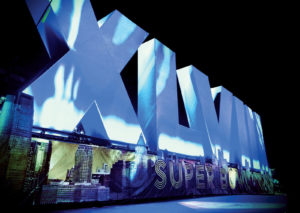
Pictured here are striking fabric structures printed by Tectonic Industries on Fisher Textiles fabrics for Super Bowl XLVIII. Photos: Tectonic Industries.
Branding has become a major fixation. From people who carefully curate their social media postings to large corporations with entire brand-focused departments and everything in between, it seems as if everyone is intent on cementing public perception of their brands. And although we’ve all likely encountered individuals who are obsessed with their “personal brand,” for the outdoor fabric graphics arena, this obsession with branding is good news.
Paul Grider, director of new product development and technical services for Dazian Creative Fabric Environments—a South Hackensack, N.J., company specializing in print media for printers servicing the retail, exhibit, interior design and special events markets—says they’re seeing a huge increase in brand marketing utilizing fabric graphics.
“Corporations are putting serious dollars behind brand exposure through trade shows, commercials, product launches, special events and sponsorships, all requiring some type of print element,” he says.
But the demand for branding via textile graphics isn’t limited to large corporations; this kind of branding is everywhere—on commercial awnings, umbrellas, banners, flags, building wraps and shade structures, roller screens and curtains, says Mike VonWachenfeldt, technical service manager for Glen Raven Custom Fabrics LLC. Headquartered in Glen Raven, N.C., the company manufactures performance fabrics and also provides research and development, dying, spinning, weaving and finishing, along with distribution and logistics.
“Direct printing and the use of digital print films through heat and vacuum processes now make graphic choices almost limitless, with growth in the banner, umbrella and specialty markets, from auto racing and other outdoor events,” VonWachenfeldt says, explaining that companies are gravitating toward fabric graphics because their texture and softer feel creates more appealing environments.
Sports marketing and the desire to encourage consumer engagement at all levels of athletics has been driving an explosion in fabric graphics, says Sharon Roland, public relations and advertising manager for Fisher Textiles, an Indian Trail, N.C., supplier of fabric for digital printing to the trade show, retail, sports marketing and event and hospitality industries. Fabric graphics are being printed on stadium runners, seat covers, pole banners and tension graphics. Street festivals are also driving up demand, thanks to their use of custom branded tents, Roland adds.
“Printed tents stand out from white, unprinted tents,” she says. “Given the structure of the tent itself, messaging is easily seen from a distance, drawing more consumer interaction with the business or brand.”
Damien Vielle, CEO of Ins’Tent Industries, home of Vitabri, is seeing the same. Located in Huntington Beach, Calif., the company is a tent and promotional items manufacturer providing a range of printed products, including tents, displays, flags and furniture. According to Vielle, his company is getting a lot of requests for tents and flags in particular, since these are the easiest way to promote any brand at an outdoor festival or event.
Outdoor textile trends
For understandable reasons, waterproofed fabrics are finding a receptive audience, says Roland. By preventing rainwater from soaking into the fabrics—which increases their weight and likelihood of tearing—these coatings enhance durability and also make the fabrics stain resistant. Some of Fisher’s most popular outdoor fabrics are the GF 1010 Element® for awnings, the GF 610 Rubber Ducky® for outdoor street pole banners, and the GF 5351 Waterfall or the GF 5355 Cascade for event canopy tents.
Barrier fencing and portable barricades deployed at festivals, sporting events and construction sites for
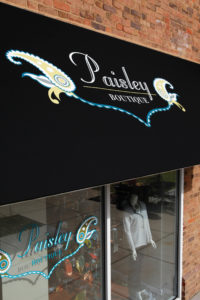
crowd control are growing trends, says Roland. “The fencing application itself is visually appealing, especially in hiding unsightly construction areas,” she says. “It presents alternative ad space for previously unused areas to highlight business, events, sponsors, musicians or athletes.”
Glen Raven provides a variety of Sunbrella® collections (such as Awning/Shade, Contour and Sheers) along with Firesist®, a commercial flame-retardant awning fabric. Fabrics in these collections are used for awnings, shades, banners, umbrellas and other items, says VonWachenfeldt, adding that Glen Raven also offers products designed explicitly for graphics. These include Sunbrella Inkjet White and Poly Oxford White with an inkjet-receptive coating compatible with solvent, eco-solvent, UV and latex inks. These fabrics are mainly constructed from, but not limited to, solution-dyed acrylic and solution-dyed polyester.
“Graphics can be applied by direct digital printing, screen printing, as well as by having printable vinyl and urethane films bonded to our fabrics in our SGS [Sunbrella Graphics System],” he says. “Graphic capabilities have become a more important aspect of the end product each passing year, expanding into other markets and market segments, from industrial covers to upholstered products.”
Dazian’s textiles are specified for temporary outdoor use or for indoor spaces with direct or indirect UV exposure, says Grider. The company’s latest offering, Acrobat®, is constructed from a new elastomeric polyester fiber, Mira-S™, that provides enhanced UV protection and colorfastness, while delivering vibrant color that won’t yellow or break down under UV light exposure.
The company also offers fabrics with water-repellent coatings, as well as meshes and scrims—which are experiencing strong demand because of their breathability, durable construction and ability to withstand harsh outdoor conditions, says Grider—along with flag cloth outdoor flags and banners, and tent/tension fabrics. The company’s outdoor print media is made from 100 percent polyester, although some have acrylic and water-repellent coatings or UV inhibitors.
Before Dazian prescribes a specific textile for outdoor use, Grider says the company wants an understanding of:
- How the graphic is being installed. “This will determine the type of finishing the print will have so it can support the structure it’s being attached to,” he explains.
- How long the graphic will be up, determining the most appropriate textile.
- Where the graphic is going and the environment. Different conditions—for example, cold/salty ocean versus dry/hot desert—require different fabrics.
When it comes to figuring out the best coatings and finishing methods, Grider again considers use and installation.
“Is this a hanging banner? Going on a dimensional structure like a tower? Knowing the intention of the print graphic helps us to select the right media,” he explains. “And, how are you planning to install the graphic? We need to make sure the technical properties of the fabric can support the application and performance expectations.”
Inks and methods
Various inks and printing methods are utilized for outdoor fabric graphics, all with pluses and caveats. Consider latex ink, says Tom Wittenberg, HP large format marketing segment manager, Sign & Decor, The Americas. Headquartered in Palo Alto, Calif., HP creates printing solutions via a broad portfolio of latex and UV printers and inks.
As Wittenberg explains, the dye-sublimation process can result in quite vibrant color. Because the material
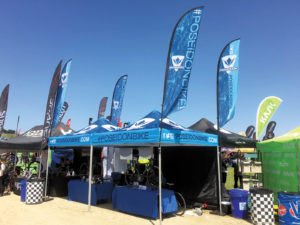
is actually dyed, images won’t rub or flake off. However, outdoors, especially with prolonged sun exposure, colors can fade. The upside of latex ink is that it is extremely fade-resistant, says Wittenberg. On the other hand, inclement weather, such as snow, rain and wind, can cause latex to flake (although, a certain amount of weather damage can occur regardless of printing method).
Latex inks are also environmentally and user-friendly, requiring no ventilation to apply. They contain no hazardous air pollutants, are odor-free and are nonflammable. Latex ink also comes
off the printer dry, allowing a secondary process, such as lamination, to be done immediately. These factors have likely contributed to the fact that, according to Wittenberg, latex printers of any make are number-one sellers worldwide.
Demand for HP’s Latex 570 printer is on the upswing; it’s a good fit for print shops doing longer runs, allowing them to operate more efficiently and to reduce costs, Wittenberg says. A beacon at the top of the printer signals when the run is done or if there’s a problem. HP also offers a mobile app that will send messages from the printer. Both allow operators to engage in other activities rather than having to physically monitor the run. Materials used typically include flag and banner textiles in addition to the 500-plus other media approved by HP.
The HP Latex 365 printer also runs fabric, but doesn’t hold as much ink as the HP Latex 570. When
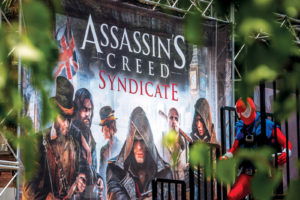
deciding between the two, Wittenberg advises print shops to consider the number of substrate runs and the volume run of each, explaining the latter is “great for running a few media in longer runs.”
Latex inks are definitely growing in popularity, says VonWachenfeldt, but UV inks are also experiencing more demand, thanks to ink improvements resulting in greater flexibility for textile applications.
“They can often be directly printed onto woven fabrics without the need of a top coating and, for the most part, are not negatively impacted by water-repellent treatments on the fabric,” he explains.
UV inks also don’t fade as quickly as some others when exposed to sunlight, says Roland, making them a good choice for long-term graphics. As for dye-sub, the rise of seasonal graphics making fading less of a concern has sparked greater use of this method for outdoor graphics, she says, adding that all of their uncoated fabrics are dye-sub compatible.
Dye-sub is the top choice for his clients, says Vielle. Although Ins’Tent offers a variety of printing techniques ranging from full digital dye-sub to silkscreen and UV printing, approximately 90 percent of the company’s outdoor projects are dye-sub. Clients want the vibrant colors, and this ink is less vulnerable to scratching, folding or wearing away, he says.
Although fading remains an issue, Vielle says he addresses this by being extremely selective about fabrics and inks.
“We spend a lot of money to get the very best ink,” he says, mentioning that Ins’Tent purchases ink from
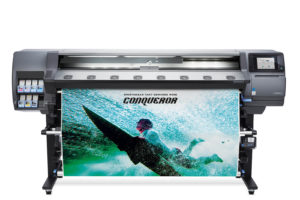
Italy. “And we select 600-denier for our tent tops. This material is strong enough for outdoor use and ideal for full digital dye-sub printing. We’re definitely able to provide vibrant, colorful printed items that last longer.”
Vielle expects demand for outdoor graphics to keep growing. “As long as there are outdoor events, companies will definitely need a branded outdoor item to represent them,” he says.
Wittenberg says the same, attributing this in part to the collaboration between textile manufacturers and the ink and printer manufacturers that have given rise to new options. He also foresees this teamwork growing. “If the market is hot, you want to grow in that market and find more avenues to support that customer base,” he says.
Ultimately, says Roland, everyone is working together. “Industry suppliers constantly release new media, new inks and new machines,” she says. “Printers and fabricators drive this segment with creative new applications and job-specific requirements for inks and fabrics, which furthers the growth and progress of this segment.”
Pamela Mills-Senn is a freelance writer based in Long Beach, Calif.
When it comes to outdoor fabric graphics, wind force is a big deal, says Roger Lepley, president of the Consort Display Group, a Kalamazoo, Mich., provider of exterior and interior displays offering eight distinct product lines.
“No matter how long or short your outdoor installation is scheduled to be up, the strength of the installation needs to be as though the next major windstorm is going to happen the very next day,” he cautions.
But, Lepley continues, calculating wind load is an inexact science. It is complicated by the fact that applications go up all over the place, on all manner of structures, at varying heights, with wind-blocking (or escalating) obstructions present or not. In addition, wind direction and velocity can constantly change and different textiles can respond differently to these forces. For example, Lepley says Consort’s tests have shown that fabrics with “wind slits” can actually increase the force of the wind on the fabric; and in higher winds, mesh can behave like solid vinyl. Given all these variables, it’s easy to understand his use of the word “inexact.” To assist with calculations, Consort provides a “Wind Force Calculator” on its BannerFlex website: www.bannerflex.com.
 TEXTILES.ORG
TEXTILES.ORG


